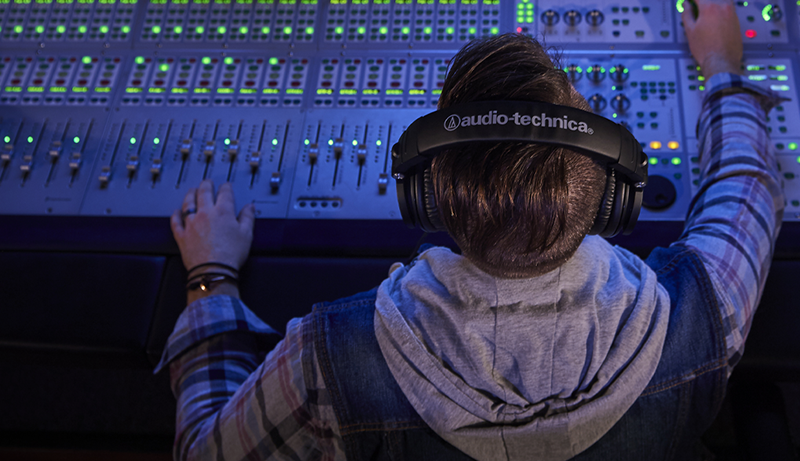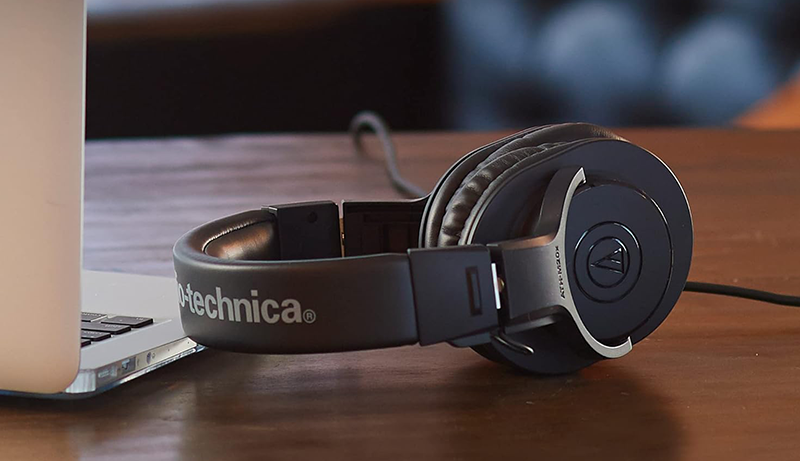I have many great memories from my time at Berklee College of Music in Boston. One not-so-great memory? Walking past the guitar practice rooms on my way to the piano rooms. It was like stepping into a chaotic music store—multiple “Stairway to Heaven” renditions clashing at once, times eighty!
Eventually, I got permission to use the quieter piano building, which was bliss—until my new roommate showed up with a massive Fender amp. Even with headphones, the sound leakage was unbearable. Thankfully, guitar headphones have come a long way.
Today’s models offer the same kind of peaceful practice experience digital pianos brought to keyboard players. If only these existed back then! Here are some of the best headphones for quiet guitar practice and recording prep.
1. Audio-Technica ATH-M50x
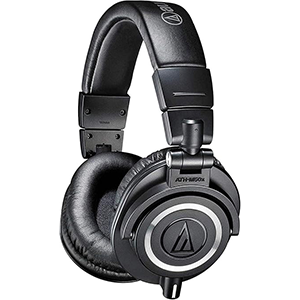
Audio-Technica has quickly become one of my favorite brands for studio headphones, and the ATH-M50x is a standout choice for guitar practice. These are arguably among the best studio headphones available for guitar players, offering an impressive frequency response of 15 Hz to 28 kHz. This wide range lets you truly appreciate the full tonal spectrum of your guitar, especially when using amp effects, both vintage and modern.
The secret behind their clarity lies in the 45 mm drivers with rare earth neodymium magnets. Unlike headphones with hyped frequencies, the ATH-M50x is tuned for a flat response, giving you accurate and reliable sound across the board.
I’ve used these while setting up guitars during live band sessions, and the ear contour design provides excellent isolation—even just five feet from a drummer, I can still focus on fine-tuning guitar tones. They also deliver a rich low end, which guitarists especially appreciate when playing seven-string or baritone guitars.
They’re foldable and include a drawstring bag for easy transport. My only gripe? The detachable cable—too easy to forget at the studio! I’m sure I’m not alone on that.
2. Boss Waza-Air
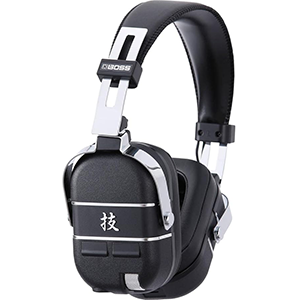
Boss has been a leader in guitar effects for decades, so it’s no surprise they’ve developed a smart, portable way to practice guitar without lugging around an amp. The Waza-Air wireless guitar headphone amp is a game-changer, offering high-quality 50mm drivers and a low-latency wireless transmitter—no need for messy instrument cables or outdated iRig setups.
One standout feature is Bluetooth compatibility, allowing you to stream music and jam along. For guitarists of my generation, this would’ve been a dream setup! And of course, Boss didn’t hold back on tone. They’ve packed in amp models and effects from their popular Katana series, giving you a range of classic and modern sounds.
What really sets this system apart is the Boss Tone Studio app. You can save and customize presets for different genres—clean, jazz, rock, metal, and more. I had a blast building mine! There’s even a built-in tuner, which is a thoughtful and practical touch.
My only real gripe? It runs on a rechargeable lithium battery with only about five hours of playtime, which can be limiting since you can’t swap in fresh batteries on the fly.
3. Sennheiser HD 280 Pro
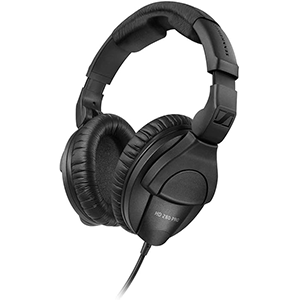
Sennheiser and Audio-Technica are longtime rivals when it comes to top-tier studio headphones, and the Sennheiser HD 280 Pro truly holds its own. These headphones shine with their excellent transient response, which might not seem critical for guitar—but it absolutely is. Being able to hear the fine details of string plucks and picking nuances can really help you lock in your rhythm, especially during fast passages.
In my experience, many newer guitarists tend to rush the beat. Drummers and pianists often rely on the clear attack of their instruments, while guitarists can sometimes get lost in effects. The HD 280 Pro helps keep you grounded by highlighting those subtle timing details.
It also features a strong frequency response, from 8 Hz to 25 kHz—slightly lower in range than the ATH-M50x, but still great for tracking and critical listening. While the low end can get a bit heavy, especially when using pedals, it doesn’t overly color your core guitar tone.
Best of all, these headphones are incredibly comfortable. They’re lightweight and perfect for long practice sessions—honestly, the most comfortable pair I’ve used while practicing guitar.
4. beyerdynamic DT 770 Pro
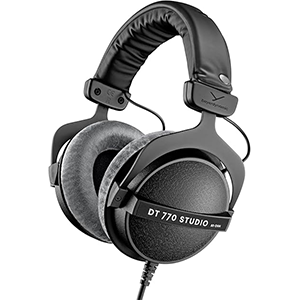
The Beyerdynamic DT 770 headphones are arguably the most high-fidelity option in this group, boasting an impressive frequency response of 5 Hz to 35 kHz. While it’s true that the human ear typically hears between 20 Hz and 20 kHz, this extended range isn’t just marketing fluff. It allows the headphones to reproduce overtones and subharmonic lows more effectively—crucial for guitar practice and amp recording, especially when distortion is involved.
Overtones are a huge part of a great guitar tone. I often use a SansAmp pedal before my amp to add some extra grit, and headphones like the DT 770 really help bring out the full harmonic richness. When dialing in distortion settings or fine-tuning pedal chains, the ability to hear those upper frequencies makes a big difference.
Another bonus: these headphones are tuned with diffuse-field EQ, meaning the enhanced high end sounds natural and won’t fatigue your ears. You get that airy, studio-quality reference sound engineers love without harshness.
The only drawback? While they’re comfortable overall, the DT 770s can feel a bit heavy over long sessions, causing ear fatigue if you’re practicing for hours.
5. Sony MDR7506
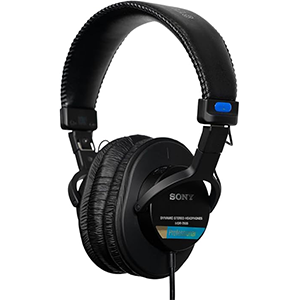
Everyone knows Sony—they’ve been producing top-notch home theater and professional studio gear for decades. For audio enthusiasts, they’re still a brand you can take seriously. Their MDR-7506 headphones are a standout, especially for music listening. Slip them on, and you’re instantly immersed—it feels like stepping into a surround sound setup.
While I originally thought of these as ideal for mixing or vocals, they’re surprisingly great for guitar, too. A guitarist friend of mine started using them while recording at Capitol Records and swears by them now. When I asked why, she explained that they let her hear every nuance when dialing in Eventide and streaming effects—almost like using pro-level studio monitors.
After trying them myself, I totally understand. If you’re into ambient guitar tones or experimental effects—think Daniel Lanois, Radiohead, Pink Floyd, or Blur—these headphones are a fantastic choice. They help you hear the depth and complexity of your sound when practicing or performing with effects.
The only drawback? They sound almost too good. Their lush tone isn’t the most accurate for mixing, so double-check with your engineer when recording. But for live playing or creative practice, they’re excellent.
Choosing the Best Guitar Headphones for Practice Sessions
When it comes to choosing the best headphones for practicing with a guitar amp, it’s important to consider your practice style and overall setup. If you enjoy jamming along to mastered tracks on streaming platforms, Bluetooth-enabled or wireless headphones with streaming support are a great option. They offer the freedom to practice anywhere—even outdoors—without the hassle of cables.
If you’re a professional or aspiring session player, you might prefer headphones with strong isolation and clarity. These are ideal for preparing tones in noisy environments or getting your levels right before a recording session. Isolating headphones also tend to have more immersive, detailed sound, which is excellent for studio work.
Traditional vs. Guitar-Specific Headphones
Among the options reviewed, only Boss and Vox make guitar-specific headphones. However, traditional studio headphones still excel when it comes to tone, clarity, and comfort. Personally, I prefer pairing a high-quality set of headphones with a good small amp over using amp-simulator headphones. While convenient, simulator models often fall short in replicating the feel and dynamics of a real amp. Practicing guitar should involve learning your gear—not relying solely on emulations.
Connectivity
Being able to easily connect your audio player—whether it’s a phone, tablet, or sampler—is a big plus for jamming along to backing tracks. Back in my college days, I had to plug everything through a mixer just to make that happen. Now, with wireless solutions like the Boss Waza-Air, you can enjoy Bluetooth streaming straight to your headphones, making the process more convenient and portable.
Still, it comes down to how often you’ll use those extra features. A quality pair of headphones isn’t limited to just guitar practice—you can use them for other listening needs too. But for this guide, the focus is on headphones that shine specifically for guitar amp use.
Sound Quality
Sound is everything. Don’t settle for average when there are so many exceptional headphones available. While something like the Vox amPhones can be fun for casual jamming, they may fall short for professional-level practice or multitasking. Investing in professional-grade headphones is worth it—they’re durable, more accurate, and elevate the entire listening experience.
Conclusion
As a keyboard player, I’ve always admired guitarists for their mobility. Guitar players can walk around with a compact rig and still access their full sound. Pianists, on the other hand, are often tied to digital setups or heavy keyboards.
Thankfully, today’s guitar headphones have changed the game. These nine models capture all the nuances of great amps, pedalboards, and playing techniques—some even include built-in effects, essentially becoming a pedalboard in headphone form.
While pianists still face portability challenges, guitarists can now practice with pro-level sound anywhere. So if you’re a guitarist, take advantage of these amazing tools. With the right headphones, your practice sessions can be quieter, more focused, and more fun than ever. Happy practicing!



